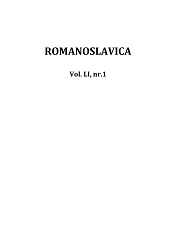Interferențe etnice la Marea Neagră și la Marea Baltică în evul mediu timpuriu (româno-slave și româno-finice)
Ethnic interference in the Black Sea and the Baltic Sea in the early Middle Ages (Romanian-Slavic and Romanian-Phoenician)
Author(s): Vlad GhimpuSubject(s): Archaeology, Cultural history, Agriculture, Social history, 6th to 12th Centuries
Published by: Editura Universităţii din Bucureşti
Keywords: Ethnic interference; Black Sea; Baltic Sea; early Middle Ages; Romanian-Slavic; Romanian-Phoenician;
Summary/Abstract: As the result of the studying of some new documentary sources from the area of the Novgorodean Cnezate, the author has founded new parallel elements of Romanian and South-Slavic colonization, came from the bottom of the Danube. With a probability almost unsure, which sustains to be mentioned the Romanians from the Dniester and the Sea, which were also called tivertsi, after their external name, together with the Novgorodean Slaves, the representants of thoses sklavenoi, attested in the Byzantine annals. It is probably that the Romanians had ethically interacted with these at the Black Sea, inclusively, with the Slovenians and with other Slavs, or Finns, in the North, at the foundation of the Izborsk, Pskov, cities communes Morevo (Mare), with the meaning of the Big, in parallel with names of the South Slovenians: Velia, Velie and Velilia; and of the other cities and Russian localities. The activity of Romanian people on the North earths is sustained also in a politic manifestation in a separate environment policy carel Tiversk and the city with the most ancient archaeological data from the 10th century, together with a fino–carel component. Being in the Novgorodean land, the Romanians lived also with another North Finnish people – the Veps; a lot of example being founded in the specific of the language. The common fields of the Veps and of the Romanian people are many: the growth of the animals, the home appliance industry, the agriculture, the catching of the fish; also had some common forms of Christian spirituality, certain social relations; finding themselves and in some similar ethnographic practices. The growth of the animals is represented in the sheep breeding terms, with examples of the Romanian organization of the sheepfold, followed by those from the home appliance industry, by the revelation of the family of some household activities inclusively from the agriculture, known at the growth of some cultures as barley, flax, hemp, and some from catching fish, as a result of local conditions with rich fishery resources. These examples confirm data from archaeological monuments in the North of the Danube (disputable, although in the scientifical extern spaces), which shows people like farmers and animal breeders, unlike the Vlachs South-of the Danube that were authorized only as cattle herders.
Journal: Romanoslavica
- Issue Year: LI/2015
- Issue No: 1
- Page Range: 55-80
- Page Count: 26
- Language: Romanian

